#Ande is portugal
Text





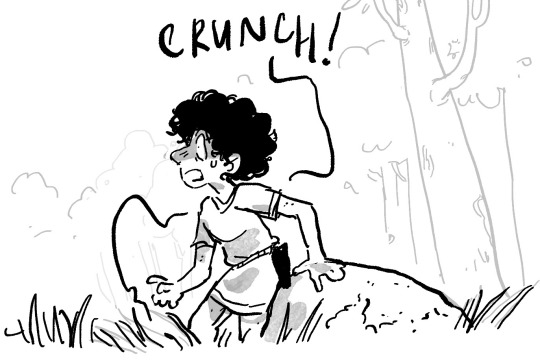




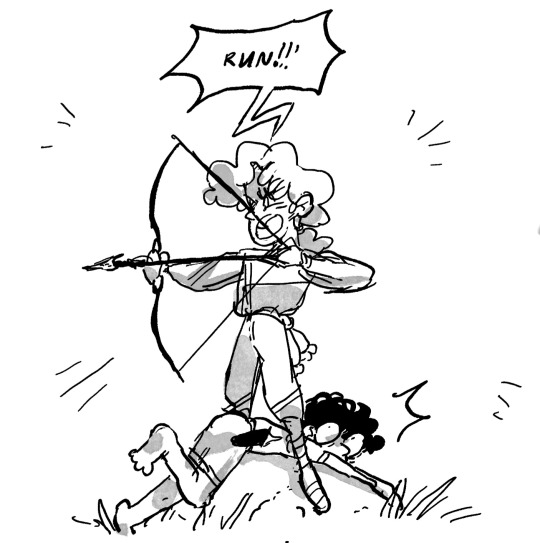
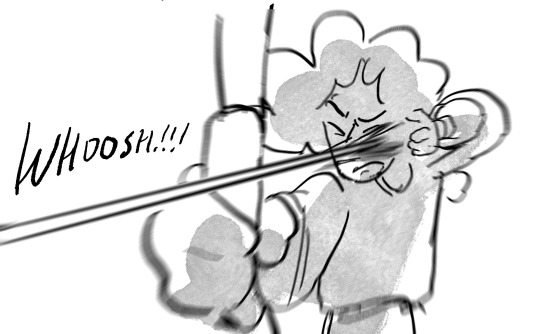
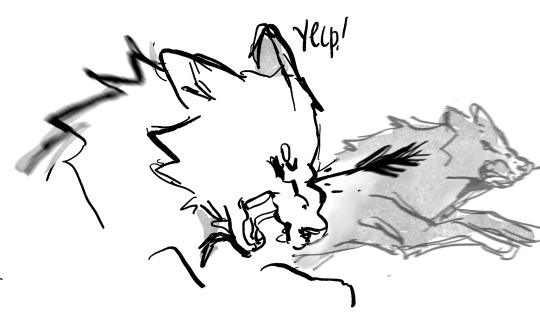
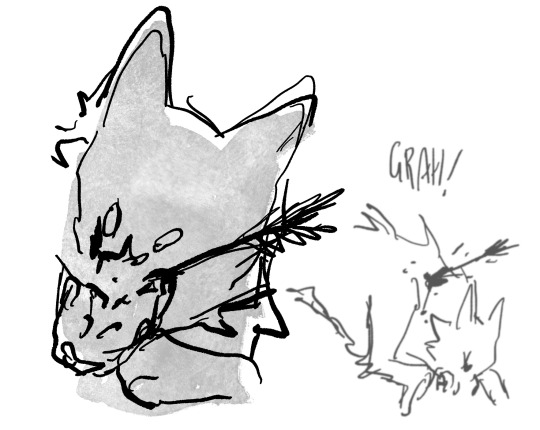

been rethinking the canon and thinking about how country personifications came to be and shit... more to come.. for now heres how Antonio and Francis met (and technically Rome)
#tw // blood#hetalia#aph spain#aph#aph france#aph rome#hws spain#hws france#hws rome#hetalia spain#hetalia world series#hetalia france#hetalia rome#also in this new canon i like to believe that they went through a couple of different nmes before taking on names such as Spain and France#Like pre-rome Antonio is Andoni#And francis is Iestenus#Ande is portugal
336 notes
·
View notes
Text

For the Encanto OC event, though given I'm trying to keep up with Inktober, I can't guarantee I'll have something ready for every week.
You can find the info for the event here, hosted by @encanto-extended-edition.
My fan character for Encanto is also a fan character for Wolfwalkers. He's depicted here in the style of Wolfwalkers, but will also appear in a style more similar to Encanto. The construction lines won't appear in the latter style, and they'll be much more subtle in future depictions in Wolfwalkers style.
Name: Séamus Goodfellowe-MacTire
Age at introduction: 17
Birthplace: Kilkenny County, Ireland
Bio: Séamus is descended from Bill Goodfellowe and Moll MacTire. He is, as far as he's been able to discern, the last surviving wolfwalker. His family has struggled with their identity since the extinction of the Irish wolf in the late 18th century, and has taken to breeding Irish wolfhounds since then. But after Séamus was orphaned and his secret came out, he was run out of Ireland, bringing a few of his family's dogs with him. He took refuge in Spain for a while, laying low among a Calé community in Galicia, who were sympathetic to his plight. They taught him Spanish and some Galician, and he was able to pick up a few words and phrases in Caló, though they never taught him their language directly, as he wasn't a full member of their community. Eventually, a combination of persecution against the Calé and suspicion surrounding an uptick in wolf activity in the region resulted in the Calé community having to relocate, and they strongly encouraged Séamus to move on, for his own safety as much as theirs.
Séamus had to leave his Spanish wolf friends behind, which deeply hurt, as they were the first actual wolves he'd ever met. But his dogs remained by his side. He decided to try his luck in Mexico, where he knew there would be wolves, and where many Irish had chosen to emigrate during the last great Irish diaspora. He took a boat from Lisbon, Portugal across the Atlantic, but storms forced them to make port in the Caribbean. Through a series of events Séamus considered bad luck initially, he wound up in Cartagena--well south of his intended target. The conflict happening in Colombia forced him further and further inland, and Séamus and his dogs all felt as if they were being pulled somewhere deep into the Andes. Along the way, Séamus ended up picking up a pack of bush dogs, who absolutely delighted him and the wolfhounds. They were the closest things Séamus could find to wolves in that strange land.
Séamus spent most of his early days in Colombia camping in the forest. Every night, he and two of his hounds would scout the trail ahead. And every night, they felt inexplicably pulled in a particular direction. So every following day, Séamus would gather his pack and head in the direction of the mysterious force.
And that's how they ended up in the Encanto.
He met Antonio first, thanks to the bush dogs. Later that same day, he met Mirabel, by then 16. His first night in the Encanto, he accidentally bit Mirabel, transferring the magic of the wolfwalker to her. Thus Mirabel became the first Colombian wolfwalker, and the only other wolfwalker in the world that Séamus knew of.
#Encanto OC event#Encanto OC appreciation#Encanto#Disney#fan character#Wolfwalkers#Cartoon Saloon#crossover
21 notes
·
View notes
Text
Here we go, fibre haul! You guys ready?

So all of these lovely bits of floof were purchased from The Fiber Imp.

The owner is so nice, I thought I'd give them a little shout out so you guys can buy any floof you like the look of here:
Most of the nerdy stuff I am sourcing my info from is a site called NWyarns.com which has great indepth info in the histories of many breeds of sheep and how they became the sheep we have today.
If I grab info from another website then I'll mention it specifically but otherwise this all comes from NWyarns.
Now let's dig in shall we?
First up, we have Rocky Mountain Skies


This one is commercially dyed and all 100% merino.
Domesticated in Mesopotamia sometime between 11,000 and 9,000 BCE
If you were not select royalty you were pretty much out of luck – there were no legitimate ways for the average sheep farmer to get a prized Merino ram or ewe until about the first decade into the 1800s. However, there were certainly illegitimate ways. Paying someone to smuggle Merino sheep out of Spain offered the chance of a prized ram or ewe. Certainly that is how the U.K. acquired their first Merino sheep (4 rams and 2 ewes), which Sir Robert Banks paid some enterprising business person to smuggle out of Spain via Portugal.
However, more often than not, it appears that the people purchasing Merinos through less than legitimate means during this time frame were either getting scammed or simply provided with any Spanish sheep that smugglers could manage to get out of Spain.
Merino is renowned for its fineness and elasticity, which can be made into woven, knitted, crocheted or felted wool fabrics that can be very comfortably worn directly against the skin. Merino is graded to a variety of micron widths including Superfine (17.6-18.5 microns), Fine or Extrafine (18.6-19.5 microns), Fine Medium (19.6-20.5 microns) and Medium (20.6-22.5 microns). Unless otherwise specified, you will find that most merino available in commercial clothing and most yarns is in the Fine Medium to Medium range. However, even though the Fine Medium and Medium Merino is the most common, it is by no means coarse! 22.5 microns is still quite fine, and extremely comfortable to wear directly against your skin.
Next up is Spellbound


75% 18.5 Micron Merino / 25% Mulberry Silk
This next bit of info comes from Casper.com:
Mulberry silk comes from the Morus Alba tree.
Originating in China over 5,000 years ago, “sericulture” is the ancient process of spinning silk.
Mulberry silk is made from the cocoon of the Bombyx mori moth. Before metamorphosis, the caterpillar feeds exclusively on the white mulberry leaf.
Smoother and stronger than any other silk in the world, mulberry silk is a textile powerhouse. Famous for its durability and lightweight quality, mulberry silk is able to retain up to a third of its weight in moisture. Because of this, it doesn’t emit a smell when damp and doesn’t need to be left out to dry for a long amount of time, making it relatively easy to manage.
Au Naturel


Undyed blend of superfine merino, dark brown alpaca, mulberry silk and baby camel.
Alpaca:
Alpacas are in the camelid family -- the same biological family as camels and llamas.
Although they can be found around the world today, alpacas originated in the Andes mountain range of South America. They are descended from vicuña, a wild camelid native to South America, in the Andes mountain range. The domestication of the alpaca for fiber and meat began up to 6000 years ago, with the people who lived in the Andes.
Alpaca hairs are hollow, making it a go-to fiber for crafters and manufacturers who are looking for softness with superior insulating properties. It is also surprisingly strong for such a soft, fluffy fiber.
Alpaca fiber comes in various qualities, ranging from fibers nearly as soft and luxurious as cashmere to lower quality fibers with a similar texture to fine wool. Most yarn and spinning fiber available relies on the high quality, fine alpaca. It is more difficult to find coarser alpaca, as there is little demand for it in North America. Alpaca is also hypoallergenic, making it very popular for people with skin sensitivities.
This next bit is from SpinoffMagazine regarding the Bactrian camel:
Bactrian camels have two humps and are found primarily in Mongolia and China.
Bactrians are the source for the soft down we associate with fine camel hair garments. Their fiber naturally sheds and can be combed away or gathered as it falls.
While the website for the Cashmere and Camel Hair Manufacturers states that Bactrian camels produce as much as 17 to 22 pounds of fiber annually, other sources cite amounts as low as 5 pounds. The higher amounts probably include both hair and down.
The outer coat and mane hair is long (12 inches or more) and coarse. It protects the animal from the elements, shedding dirt and water. The fine undercoat is much shorter, averaging 1 to 5 inches long, although it usually measures less than 3 inches in length. Some of the fiber shortness in commercial camel preparations may result from the dehairing process. The micron counts (fiber diameter) for camel fiber have a huge range. While the down averages 20 to 23 microns (similar to Merino wool), it can be as fine as the finest cashmere.
Samples from some United States Bactrian camel hair that had all the outer coat fibers removed ranged from 6 to 120 microns, with most of the sample measuring 18 to 19 microns. Camel hair has some crimp and a small amount of elasticity.
When working with the fiber in batt form (a cloud of carded fiber), I simply peel off thin layers of fiber.
Rovings (strands of carded fiber with a small amount of twist) and top (strands of long fibers in parallel arrangement) require no further preparation although they are sometimes easier to spin when split into narrower strips.
Because the camel fiber is short, thin strands of roving or top will probably drift apart if you try to predraft. You can also prepare for a lightweight yarn by handcarding the down fiber from any form into rolags.
This next bit of fibre is what pulled me into the shop in the first place, Dragon's Breath


Bamboo:
In the late 19th century, the first semi-synthetic fiber in history was invented – viscose rayon! Known as artificial silk until its rebranding as rayon in 1924, rayon has become a significant part of our fiber landscape.
In the yarn and fiber world, we most frequently run into rayon when it is labeled as bamboo or viscose.
More recently, you can also buy viscose rayon labeled as rose fiber (having been sourced from the cellulose of rose bushes), or even purchase viscose rayon fiber that comes from seaweed.
While these fibers are often advertised as eco-friendly because they come from plants, that is not necessarily the case.
It has had a history of adverse health effects on the workers involved in its manufacture right up to the present day.
A short and somewhat abbreviated version of viscose rayon production goes something like this.
All rayon begins with pure cellulose. This cellulose is treated with a caustic soda, and goes through a number of curing processes and chemical treatments, including a process called Xanthanation in which it is mixed with carbon disulfide. The resulting material is dried and ground into a powder, and is dissolved in yet another caustic solution to form the viscose, the viscous solution from which viscose rayon receives its name. Allowed to stand for a period of time, the viscose solution is strained and then extruded through spinnerets, which land in a bath of sulfuric acid, forming rayon fiber. The fiber is then washed to remove any residual chemicals and make it safe for the wearer.
By the time rayon fiber and fabric hits the market, there are no traces of any chemicals that could harm the person wearing it. The same can’t necessarily be said for the factory workers, either in the past or today.
They go into more detail if you want to dig in further but I will need to research more myself before I commit to further bamboo purchases.
I will continue this in part 2!
#long post#wool#alpaca#camel#bamboo#fibre#show and tell#fiber#hand spinning#yarn#craftblr#part 1#haul
23 notes
·
View notes
Text
Tal día como hoy 13 de octubre ...
2010: Concluye de manera exitosa el rescate de los 33 mineros atrapados en la mina San José, cerca de Copiapó (Chile), atrapados por un derrumbamiento producido 69 días antes a 720 metros de profundidad. Siendo un evento con una cobertura mediática mundial.

1983: Entra en funcionamiento en Estados Unidos el primer sistema de telefonía celular o telefonía móvil, AMPS (Advanced Mobile Phone System).
1972: Se estrella en los Andes el vuelo FAU 571 con el equipo de rugby Old Christians Club a bordo, con destino Santiago de Chile. Este hecho dio lugar al 'Milagro de los Andes', por como consiguieron sobrevivir en condiciones de extrema dureza 16 de los 45 ocupantes.

1959: La NASA lanza el satélite Explorer 7 para la investigación de las partículas energéticas en el espacio.
1930: EL ingeniero italiano Corradino D'Ascanio presenta el helicóptero D'AT3 para que realice su primer vuelo en el aeródromo de Ciampino.
1917: Ocurre el 'Milagro del sol' cerca de Fátima (Portugal), en el que parte de los más de 70.000 asistentes aseguraron ver moverse y zigzaguear al sol. Tal y como habían profetizado los pastorcitos Jacinta Marto, Francisco Marto y Lucía dos Santos a los que se les había aparecido la Virgen María y les había comunicado que realizaría milagros en esta fecha.

1843: La reina Isabel II de España decreta los actuales colores de la bandera nacional, amarillo y rojo de la enseña de guerra de la Armada.
1830: En el Congreso General de México se decreta la división del Estado Interno de Occidente en dos estados: el Estado de Sonora y el Estado de Sinaloa.
1792: Comienzan las obras de la Casa Blanca en Washington (Estados Unidos), un proyecto ideado por el primer presidente George Washington en 1790 para crear la residencia de los presidentes.

54: Es proclamado emperador Nerón, en Roma, con sólo 16 años de edad y el mismo día que moría envenenado el emperador Claudio.

10 notes
·
View notes
Text
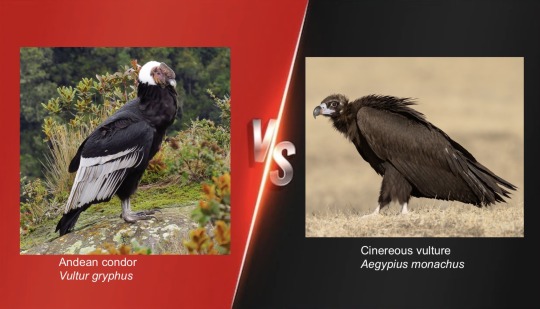
The giant of South America vs the giant of Eurasia!
Andean condors are the largest birds of prey in the world and, on average, the heaviest flying bird. They weigh from 7.7-15 kg (17-33 lb) and their wingspan can reach up to 3.3 m (10 ft 10 in), but averages around 2.83 m (9 ft 3 in). Their range extends throughout the Andes Mountains in South America. They prefer open, rocky areas. Unlike many raptors, the male is larger than the female and displays a large comb atop his head. At carcasses, these condors are the dominant scavengers in their range. They roost in large groups. They are also one of the longest-lived birds: wild birds may live past 50, and an individual in captivity lived to a whopping 79 years! Andean condors are considered vulnerable, especially in the northern part of their range, due to habitat loss and secondary poisoning.
Cinereous vultures are the largest Old World vultures and the largest members of the Accipitridae family, with a wingspan of 2.5–3.1 m (8 ft 2 in – 10 ft 2 in) and weighing a whopping 6.3-14 kg (14-31 lb). They live across Eurasia, from Portugal to Iran to Korea, preferring dry, mountainous, open areas like steppes and shrublands at high elevations. They are largely solitary but may congregate in groups around large carcasses. Cinereous vultures mostly eat carrion but have also been recorded catching live prey. At carcasses, these vultures are dominant, able to fend off other scavengers including foxes, eagles, and other large vultures. As the strongest vultures in their range, they are often relied upon to tear open tough skin and break rib bones for access to carcasses. Also, the Hebrew word for “eagle” is also used for the cinereous vulture, meaning that references to eagles in the Bible could also be referring to cinereous vultures. They are classified as near threatened due to secondary poisoning.
27 notes
·
View notes
Note
Yani!!! Seguís viva!!! Me crucé tu blog por casualidad de vuelta después de años. Por lo que veo seguís escribiendo, qué genial. Ojalá tengas re lindo día ^-^
P.S seguís teniendo tu yogurtera?
Hola! Cómo estás? Me mudé a Portugal en Diciembre así que lamentablemente tuve que dejar mi bella yogurtera atrás (rip), pero acá los yogures salen 6 por 1.50 así que me castigo a yogurt todos los días.
Sigo escribiendo aunque como hago cosas más largas posteo menos, me gustaría volver a hacer cosas cortas pero bueno, me estoy acomodando acá aún. Estoy bajando un montón la ansiedad y el insomnio etc. Diría que recuperé la alegría de vivir pero eso nunca tuve así que digo que estoy bastante mejor. Sólo me queda conseguir trabajo y mandar a traer a mis gati hijos (iban a venir conmigo pero no quedaba lugar en el avión así que se negaron a venderme pasajes para ellos).
Como siguen tus plantas? ❤️ Espero que andes bien y no se esté prendiendo fuego todo por allá.
3 notes
·
View notes
Photo

Reaja, repense, reflita, mude, altere, reveja, aceite, revide, resmungue, crie, pinte, borde, flutue, compre, guarde, ofereça, ande, corra, levante-se, perdoe, descanse. SE FAÇA FELIZ.
- Ita Portugal
15 notes
·
View notes
Text
i think it’s funny how rowling placed mexico with the rest of north america and the entirety of latin america except mexico in the same school.
in truth, being brazilian myself and an avid observer of geography and statistics; it’s more likely that brazil (not mexico but correlated) would have its own wizarding school, perhaps gathering students from the entire portuguese speaking world (portugal, mozambique and angola specifically), and it wouldn’t be located in the amazon, that’s for sure. who the hell wants to study magic being bitten by mosquitoes all the time? the southern or southeastern highlands are more likely to me. deep minas gerais state sounds just perfect, and very brazilian. and the castle itself would look nothing like an aztec temple or something, but rather like this.
brazil is very much isolated from the rest of latin america, to the extent brazilians ourselves often don’t know we’re classified as latinos by americans and europeans. the language barrier and the sheer size of our country (given it wasn’t broken in 20 different countries like hispanic america) makes isolationism quite easy and so we don’t mingle with the rest of latin america as much.
thus, the rest of latin america (and the caribbean possibly, though i quite like the idea of a jamaican school) would have its own wizarding school, which i imagine could be located in the andes or the mexican highlands. the andes sound just perfect though - isolated and its climate is cool enough for studying. since rowling herself didn’t imagine a hispanic american wizarding school, i can’t google it for cool fan arts. (also given that the andes and the mexican highlands were both the seats of the two largest empires in pre-columbian america, they could after all have their own separate wizarding schools; the andean one serving students from southern latin america and the mexican one from northern)
and the u.s. would still have its own school along with canada. canada just gets dragged along all the time anyways. though some students could choose the french school i guess?
imo rowling just got lazy when designing the rest of the wizarding... globe. it makes no sense that the british isles would have its own school but all of europe gets lumped together and the same for latin america or asia & oceania. and let me not get started about the names. “castelobruxo” is a lazily anglicised way to spell “witching castle” in portuguese, and sounds nothing like a real place name. “castelo de magia” (magic castle or something) would make more sense if she wants to be plain. but since hogwarts (warts on hogs??) doesn’t sound anything close to normal in english i imagine a portuguese name for a wizarding school would also sound alien. if she did it for hogwarts, she could do it for us.
unfortunately harry potter suffers from lazy worldbuilding outside of the british isles. i guess rowling’s behavior in the last few years makes suspension of disbelief a little bit harder is all.
#harry potter#worldbuilding#ritalin.txt#listen rowling wasn't autisti enough for worldbuilding is what i'm getting at#i'm 100% sure tolkien and martin are neurodivergent#neurotypicals can't do this stuff#yes i'm flexing
14 notes
·
View notes
Text
Mining Language is an exemplary and erudite study in how deep attentiveness to language and to the challenging work of locating and comparing disparate and often fragmentary sources can yield new insights into knowledges and agencies that have been rendered invisible by colonialism. It is also a vivid illustration of how a literary approach can breathe life into material phenomena [...].
Iberian colonial archives abound with a wealth of materials, visual as well as written, that shed light on the mining, refining, and circulation of metals, a phenomenon that was central to the economic and symbolic functioning of empire. [...] Nevertheless, their partial and fragmentary quality is acutely apparent in the frequent absence of the voices and experiences of Indigenous and African miners who, individually and through diverse communities, profoundly shaped mining ventures in Spain’s and Portugal’s New World domains. [...] In this deeply researched and original monograph that focuses primarily on Iberian and especially Spanish spheres of colonization in America, Allison M. Bigelow advances the project of bringing Indigenous and African mining knowledge into view through the deep study of linguistic clues [...]. At the same time, the author deploys linguistic study to shed light on the racial logics that emerged from and were fortified by the colonial mining industry. [...] Tracing a rough chronological arc of three hundred years from the earliest years of Spanish conquest to the late eighteenth century, Mining Language is wide-ranging [...].
-------
The opening chapters focus on the exploitation of gold within the first century of the Spanish invasion in the Caribbean islands and Central America and demonstrate how Taíno expertise in gold extraction and working, and the place of this metal within Indigenous societies, shaped the geographies, vocabulary, and even the temporal rhythms of colonial gold mining, despite the intensely destructive impact of Iberian colonization in this region. [...] The third section turns to copper [...]. The chapters examine how copper surfaced in and shaped Spanish and Portuguese narratives of early colonial ventures in Florida and the wider Southeast, and how an early seventeenth-century proposal envisioned the formation of a copper-mining community in Venezuela that would rely on African technical expertise even as enslaved African workers were imagined primarily as “embodied labor” (p. 225). [...] By drawing on varied archival sources, mining treatises, and dictionaries, Bigelow seeks to demonstrate that Indigenous knowledges and political formations, in Mexico and the Andes alike, were vital to the silver-production process to an extent that has not been fully recognized by scholars. Further, through a deep linguistic study of early and mid-colonial Andean mining vocabularies, the author traces the intertwining and mutual shaping of the silver industry and the circulation of ideas about race, color, and caste. [...]
-------
In the early colonial gold frontiers of the Caribbean islands, linguistic patterns reflect the speed with which Indigenous gold-mining knowledges were incorporated into colonial practices: among other examples that could be cited, Bigelow argues persuasively that the verb xamurar or jamurar, which means “to bail water” (an important part of the gold-mining process), has Taíno rather than Catalan roots -- an origin that was quickly forgotten [...]. Bigelow’s painstaking comparative work suggests that subtle linguistic patterns in colonial sources [...] reveal more than a straightforward colonial incorporation of Indigenous technical mining terms. [...].For instance, Cristóbal Colón’s neologism coger oro (to gather gold), which he used in his discussions of gold extraction in the Caribbean, may reflect the “metallic cosmologies” (p. 24) of the Taíno, for whom gold, like plants and other natural phenomena, was a substance to be harvested at particular times of year, in cycles that were associated with the continuity of life. [...]
-------
On the one hand, Portuguese, Spanish, and English sources reveal striking similarities in the ways in which Europeans valued copper in the context of New World colonizing ventures. By contrast, a detailed comparison of late sixteenth-century medical dialogues shows that European understandings of iron were far from homogeneous and strongly shaped by the contexts in which they were produced. García d’Orta, for example, a Portuguese physician who wrote about healing practices while resident in Goa, resisted dominant Portuguese understandings of the value of iron by making room in his dialogic text for South Asian views of iron as a metal that was associated with paradise.
Here again, Bigelow’s careful attention to the evolution of texts in translation reveals how non-European ways of knowing, and even the variations between Iberian forms of knowledge, were rendered invisible: when d’Orta’s writing was translated from Portuguese into other languages, these voices and nuances disappeared. In comparable fashion, a comparative reading of German, French, and English translations of Álvaro Alonso Barba’s mining manual Arte de los metales (Art of Metals) reveals the extent to which Andean understandings of metals and their categorization were erased in the process of translation.
-------
If ambitious juxtapositions and comparisons of sources that extend well beyond New World arenas of Iberian colonization are a hallmark of this study, so too are the author’s efforts to bring colonial knowledge of metals into conversation with realms of colonial life -- among these, imaginative constructions of race -- that tend to be treated separately in existing scholarship. In the section on silver, the reader learns that colonial mining and refining practices in the Andes were shaped by notions of color and caste and how these were also reinforced by the silver industry. The late sixteenth-century transition to refining silver ore with mercury required new practices of ore sorting and classification, as well as new expressions to categorize ore and the particular forms of labor that amalgamation required. As Indigenous Andean mining terms were incorporated into a constantly evolving colonial mining lexicon, they became divorced from their original associations and eventually were “replaced with an emerging discourse of color, casta, and race” (p. 292).
-------
Text by: Heidi Scott. “Scott on Bigelow, ‘Mining Language: Racial Thinking, Indigenous Knowledge, and Colonial Metallurgy in the Early Modern Iberian World.’“ A book review by Heidi Scott. Published on H-LatAm. October 2021.
36 notes
·
View notes
Text
Sunday, August 6, 2023
Vermont’s flood-wracked capital city ponders a rebuild
(AP) A beloved bookstore in Vermont’s small capital city moved across the street to a new spot farther from the Winooski River after an ice jam sent river water into the store in 1992. A nearby office supply and gift store did the same in 2011 because it liked a different space that came with a bonus: it was higher and farther from the river. But their moves to higher ground weren’t enough to save them from flooding after torrential rains in July caused what some saw as the state’s worst natural disaster since a 1927 flood that killed dozens of people and caused widespread destruction. Some communities suffered more severe flood damage this year than when Tropical Storm Irene ravaged the small, mountainous state in 2011. Now the mostly gutted shops, restaurants and businesses that lend downtown Montpelier its charm are considering where and how to rebuild in an era when extreme weather is occurring more often.
Thousands overwhelm New York’s Union Square for streamer giveaway, tossing chairs and pounding cars
(AP) A crowd of thousands that packed Manhattan’s Union Square for a popular livestreamer’s hyped giveaway got out of hand Friday afternoon, with some clambering on vehicles, hurling chairs and throwing punches, leaving police struggling to rein in the chaos. Aerial TV news footage showed a surging, tightly packed crowd running through the streets, scaling structures in the park and snarling traffic. Shouting teenagers swung objects at car windows, threw paint cans and set off fire extinguishers. Some people climbed on a moving vehicle, falling off as it sped away. Others pounded on or climbed atop city buses. By 5:30 p.m., police officers in growing numbers had regained control of much of the area, but small skirmishes were still breaking out, with young people knocking over barricades and throwing bottles and even a flowerpot at officers. Officers arrested 65 people, including 30 juveniles.
Lake Titicaca drying up as heat wave turns winter upside down
(Reuters) The parched shoreline and shrinking depths of Lake Titicaca are prompting growing alarm that an ago-old way of life around South America’s largest lake is slipping away as a brutal heat wave wreaks havoc on the southern hemisphere’s winter. Like many places suffering deadly consequences of climate change, the sprawling freshwater lake nestled in the Andes mountains on Bolivia’s border with Peru now features a water level approaching an all-time low. Titicaca is only 30 cm (1 foot) away from reaching its record low of 1996 due to severe drought, said Lucia Walper, an official with Bolivia’s hydrology and meteorology service. Farmers in the adjacent Huarina community are desperate for help. Historic drought in South America has also slammed neighboring Argentina’s crucial farm sector, prompting the International Monetary Fund to forecast a 2.5% economic contraction this year as a result.
Mediterranean fires offer lessons—and warnings—for Europe
(Washington Post) As the Mediterranean’s summer heat waves grow fiercer, so too do its ravenous wildfires. They killed 34 people in Algeria last month. In Greece, 19,000 were forced to evacuate. Italian firefighters tackled 1,400 fires in just three days last week. In Tunisia, where temperatures soared to 120 degrees, families are picking up the pieces after scores of homes and farmlands were engulfed by flames. Responses differed in each country. Some relied on a domestic firefighting plane fleet; others called for help. Wealthier nations had more elaborate evacuation and response plans than their poorer counterparts in North Africa. For experts, though, it all pointed to a frightening new reality: Wildfires are getting too severe, too frequent and persistent, and raging over too vast an area to contain without robust prevention measures. And the risk is spreading. “Southern Europe—Spain, Portugal, Greece, Italy—they struggle with wildfire; but as global warming continues, we’re talking about wildfires in the forests of Germany, Austria, Slovenia,” said Craig Clements, director of the Wildfire Interdisciplinary Research Center at San José State University. “It’s happening here. Europe knows it’s going to happen. They’re preparing for it.”
Russia’s war with Ukraine has generated its own fog
(AP) On the battlefields of Ukraine, the fog of war plagues soldiers. And far from the fighting, a related and just as disorienting miasma afflicts those who seek to understand what’s happening in the vast war. Disinformation, misinformation and absent information all cloud civilians’ understanding. Officials from each side denounce devious plots being prepared by the enemy, which never materialize. They claim victories that can’t be confirmed—and stay quiet about defeats. None of this is unique to the Russia-Ukraine conflict. Any nation at war bends the truth—to boost morale on the home front, to rally support from its allies, to try to persuade its detractors to change their stance. But Europe’s largest land war in decades—and the biggest one since the dawn of the digital age—is taking place in a superheated information space. And modern communications technology, theoretically a force for improving public knowledge, tends to multiply the confusion because deceptions and falsehoods reach audiences instantly.
Earthquake victims in Turkey and Syria still need our help
(Global Christian Relief) In the early morning hours of Feb. 6, 2023, residents of Turkey and northern Syria were awakened by rumbling. In Turkey alone, the magnitude 7.8 and 7.7 earthquakes killed more than 50,000 people and injured more than 100,000 others. At least 15 million people in all and 4 million buildings were affected. In Syria, nearly 8,500 were killed, including 2,000 children. More than 5 million people were left homeless, and more than half of Syria’s entire population was impacted. While those of us living in the West were briefly concerned with this tragedy, our attention has waned over the six months since. A war in Ukraine, protests across Iran, saber-rattling from North Korea, deadly heat waves across the continental United States and numerous other stories have captured our collective gaze. Yet the needs of those affected by the earthquakes remain great. In Turkey, an estimated 4 million children still require humanitarian assistance. More than 1.5 million people are still living in tents or temporary shelters, some without access to potable water. Many families are trying to survive in cramped, overcrowded conditions with as many as 20 living in a single tent, and countless children are struggling to cope with the mental anguish caused by the quake.
Pakistani police arrest former Prime Minister Imran Khan
(AP) Pakistani police on Saturday arrested former Prime Minister Khan at his home in the eastern city of Lahore. It’s the second time the popular opposition leader has been detained this year. Earlier Saturday, a court convicted him in an asset concealment case, handing down a prison sentence that could see him barred from politics. The Islamabad court issued the arrest warrant after convicting Khan, with police in Lahore moving quickly to take him from his home to the Pakistani capital. It’s a fresh blow to Khan’s bid to return to power. Since his ouster from power in a no-confidence vote in the parliament in April 2022, Khan has been slapped with more than 150 legal cases, including several on charges of corruption, terrorism and inciting people to violence over deadly protests in May that saw his followers attack government and military property across the country.
Flooded rivers, trapped residents test China’s disaster response
(Reuters) From coping with dangerously swollen rivers to helping residents trapped in waterlogged cities, China’s disaster-response systems are being put to the test after one of the strongest storms in years brought record rainfall that could take weeks to recede. Typhoon Doksuri battered northern China this week with extreme rain, breaking Beijing’s 140-year rainfall record and dumping volumes of rain that normally fall in a whole year in the populous province of Hebei. As the last of Doksuri’s rain drift into China’s northeastern border provinces, a region the size of Britain is grappling with the aftermath and the urgent tasks of safely discharging overflowing water from reservoirs and rescuing tens of thousands of people trapped in their homes. As of Thursday, more than 1.2 million people in Hebei had been taken to safety. The volume of rain that fell in the province exceeded the storage capacity of its large and medium-sized reservoirs by more than two-fold, state media said.
Thousands of teens to evacuate from World Scout Jamboree amid heat wave
(Washington Post) Members of the American, British and Singaporean contingents attending the World Scout Jamboree in Buan, South Korea, are preparing to pack up their tents and move out, as a heat wave caused hundreds of injuries and threatened to cut short the quadrennial international event. The moves come as hot weather and humid conditions have pushed hundreds at the event to seek medical help. Close to 1,500 people received treatment for insect bites, skin rashes and heat injuries on Friday, the event organizers said. At the opening ceremony days earlier, 139 people suffered heat injuries, headaches and abdominal pain, the event’s organizers said. The World Jamboree gathers tens of thousands of teens aged 14 to 18, plus adults, from Scout associations worldwide every four years.
Fighting has plunged Sudan into a humanitarian catastrophe, senior UN officials say
(AP) The conflict in Sudan has left 24 million people—half the country’s population—in need of food and other assistance, but only 2.5 million have received aid because of vicious fighting and a lack of funding, two senior U.N. officials said Friday. Eden Worsornu, director of operations for the U.N. humanitarian agency, and Ted Chaiban, deputy executive director of the U.N. children’s agency UNICEF, who just returned from Sudan, painted a dire picture of devastation and upheaval in Sudan, with no peace talks in sight. Worsornu said hotspots, such as the capital of Khartoum and the southern Kordofan and western Darfur regions, “have been shattered by relentless violence.” Nearly 4 million people have fled the fighting, facing scorching heat up to 48 degrees Celsius (118 F), and threats of attacks, sexual violence and death, she said.
Niger’s Coup Leaders Sever Ties With France, as Detained President Pleads for Help
(NYT) Niger’s coup leaders on Thursday said that they had severed military ties with France, their country’s former colonial ruler, throwing into uncertainty the future of 1,500 French troops based there, in a region of West Africa plagued with coups and Islamist insurgencies. The leaders of the coup also dismissed Niger’s ambassadors to France and the United States, another military partner, as well as the ambassadors to Togo and Nigeria, an essential trade partner. In an extraordinary move, the elected president of Niger, who has been locked up in the presidential palace by his own guards for ten days, wrote an opinion column published in The Washington Post calling on the United States and other allies to help restore constitutional order. “I write this as a hostage,” President Mohamed Bazoum said in his opinion essay, published on Thursday evening. “Niger is under attack from a military junta that is trying to overthrow our democracy.” He warned that attacks from jihadist groups could increase and that Russia could expand its influence in the region if the coup leaders remain in power.
Typhoons flooded her wedding. She waded down the aisle anyway
(Washington Post) It is a walk most brides never forget. But for one bride in particular, her journey down the aisle toward her future husband was particularly memorable on Sunday. It involved wading through water in a flooded church in the Philippines, as deadly typhoons unleashed heavy rainfall and wreaked havoc across the country. Footage taken inside the Barasoain Church in the city of Malolos, Bulacan province, shows Dianne Victoriano gliding down the flooded aisle, her white dress and long veil submerged in ankle-deep water. Guests surrounding her hitched up their own dresses. Some wore gum boots. Others paired flip-flops with their rolled-up trousers. Despite the venue being flooded after heavy rain swamped Bulacan province, the bride could be seen beaming as she walked through the water clutching a bouquet of pink and white roses. As some commentators on social media put it: “for wetter, for worse.”
2 notes
·
View notes
Text
DOS CASAS EN PONTE DE LIMA









Quinta de Anquiao, Portugal. 2001-2002
Eduardo Souto de Moura
Eduardo Souto de Moura, nacido en Oporto, Portugal, en 1952, empezó los estudios de Arte en la Escuela de Bellas Artes de Oporto; más tarde cambió esta disciplina por los estudios de Arquitectura, de los que obtuvo el título de arquitecto.
Influenciado por Mies Van der Rohe y por Fernando Távora y habiendo trabajado para Álvaro Siza, sus obras se caracterizan por los inusuales colores que adquieren los materiales que utiliza. En 2011 ganó el Premio Pritzker por obras como `Dos Casas en Ponte de Lima´, `Casa das Histórias Paula Rego´o el estadio municipal de Braga.
En este proyecto de dos viviendas Souto de Moura celebra y deconstruye, de forma simultánea, el ideal de Le Corbusier de una arquitectura liberada de su terreno. De esta forma la casa horizontal parece ingrávidamente suspendida en el aire. La casa inclinada, por el contrario, parece haberse despeñado al asentarse paralelamente a la inclinación de la pendiente.
Aunque idénticas en volumen, cada casa presenta una organización del espacio distinta por completo; la casa horizontal presenta una planta frente a la inclinada que cuenta con dos plantas. Pero puesto que los pavimentos son horizontales, al jugar con las superficies inclinadas de la cubierta y las paredes exteriores, surgen espacios inusitados.
La construcción de ambas viviendas, de dimensiones similares, se ha resuelto empleando materiales idénticos: estructura de hormigón (muros y losas), acabados interiores a base de revoco de estuco en los paños verticales y de imprimación de resina en los suelos, carpinterías de aluminio y cubierta de chapa de cobre.
Partiendo de un terreno con una inclinación muy elevada (45º) y de dos casas con el mismo programa, desarrolló dos ideas: una actitud natural y otra artificial. Con la primera pretendió arroparse en el paisaje, produciendo unas sensaciones en el interior de la vivienda de rasante, cobijo y cercanía; sin embargo, con la segunda, la propuesta era contraria, buscaba alzarse sobre el entorno, procurando la elevación de la vista y perdiendo ésta en el paisaje de la sierra.
Los principales rasgos de su arquitectura son el rigor y la precisión en las formas, así como una profunda sensibilidad hacia el contexto. Sus edificios demuestran un interés por el minimalismo y por querer facilitar la vida de las personas que los habitan.
De ahí que su concepción de las viviendas unifamiliares de una planta o dos sea ya su seña de identidad, así como el cuidado que pone en adaptar la construcción al lugar en el que se halla; y que las claves para comprender sus diseños sean desde percibir cómo ha integrado la estructura en el lugar, ya sea urbano o rural, hasta su interés por crear edificios de una o dos plantas diáfanas.
Tiene una fuerte relación con el minimalismo, desde que comenzó a estudiar la escultura en la Escuela de Bellas Artes de Oporto, en donde tuvo un encuentro con Donald Judd, uno de los artistas estadounidenses minimalistas más importantes que por su obra es influencia en arquitectos y artistas de la segunda mitad del siglo.
Se cree que en esta obra pudo influirle la frase de su maestro Távora “En Arquitectura lo contrario también es verdad”.
Ruby, I. & Ruby, A. (2006, 17 enero) Groundscapes: El Reencuentro Con el Suelo en la Arquitectura Contemporánea- Land & Scape (Spanish and English Edition) (1.ed). Editorial Gustavo Gili, S.L
Souto de Moura, Eduardo - Edificios y Proyectos. (2018, 23 julio). WikiArquitectura. Recuperado 20 de septiembre de 2022, de https://es.wikiarquitectura.com/arquitecto/souto-de moura eduardo/
Luis Ferreira Alves (Mar, 20 sep 2022). Dos casas en Ponte de Lima, Quinta de Anquiao. ArquitecturaViva. Dos casas en Ponte de Lima, Quinta de Anquiao - Eduardo Souto de Moura | Arquitectura Viva
Nidia Alvarez (Vir, 30 agosto 2013). Eduardo Souto de Moura, contexto y minimalismo. Los andes. Eduardo Souto de Moura, contexto y minimalismo | Arquitectura (losandes.com.ar)
Souto de moura -2 casas en ponte lima. (s. f.). Paperblog. Recuperado 20 de septiembre de 2022, de Souto de Moura. Dos casas en Ponte de Lima
7 notes
·
View notes
Photo

Óleo de Rosa Mosqueta, tudo o que sempre quis saber... Elixir de beleza popularizado pelas avozinhas, o óleo de rosa mosqueta é o eterno todo-poderoso contra estrias, cicatrizes e rugas. O melhor disto tudo? É 100% natural. O óleo de rosa mosqueta é conhecido por fazer "milagres". Duas a três gotas por dia, antes do deitar, é o suficiente para acordar com uma pele aparentemente rejuvenescida. Obtido a partir das sementes da planta silvestre rosa mosqueta que cresce na região sul dos Andes chilenos, este óleo é rico em vitamina A, colagénio e ácidos gordos, como o ácido oleico, linoleico e alpha-linolénico. O seu efeito regenerador é conhecido por atenuar as estrias, cuidar das cicatrizes e aliviar as rugas e linhas de expressão da idade. O óleo de rosa mosqueta é também um importante aliado para melhorar a pele seca. Através dos seus poderosos componentes, deixa-a suave, nutrida e sedosa em minutos. Fonte: MIranda / Sapo www.shalomnature.pt 🌳 🌿 🍂 (em Faro - Algarve, Portugal) https://www.instagram.com/p/CpqQMiwInCU/?igshid=NGJjMDIxMWI=
2 notes
·
View notes
Text
CASA EN TOLÓ
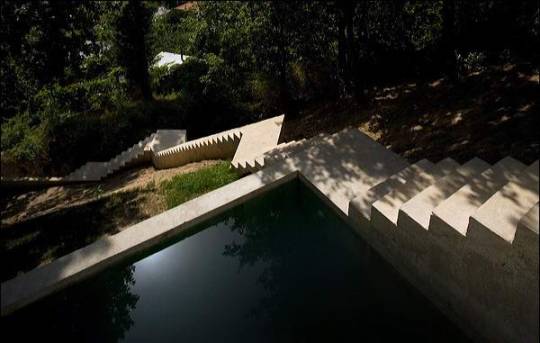



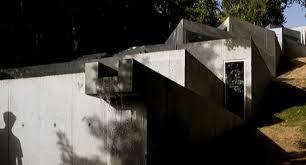




•ARQUITECTO: Alvaro Siza
•UBICACIÓN: Cerva, Vila Real
•CRONOLOGÍA: 1999
•BIOGRAFÍA DEL AUTOR
Arquitecto portugués nacido en Matosinhos (próximo a Oporto) en 1933.
Aunque de adolescente se interesó por la pintura y la escultura, con 15 años decidió su vocación de arquitecto al descubrir a Gaudí. Comenzó sus estudios de arquitectura en 1949, en la Escuela de Arquitectura de la Universidad de Oporto, que finalizó en 1955. Durante sus años de estudiante realizó su primer proyecto construido en 1954. Entre 1955 y 1958 colaboró en el estudio del arquitecto Fernando Távora.
Impartió clases en la universidad de Oporto, desde 1966 hasta 1969, y se convirtió en catedrático de construcción en 1976. Trabajó como profesor invitado y conferenciante en las Universidades de Pennsylvania, Los Andes de Bogotá, la Escuela Politécnica de Lausana, y en la Escuela Graduada de diseño de la Universidad de Harvard.
Álvaro Siza es uno de los arquitectos más conocidos del panorama arquitectónico portugués en la actualidad. Entre su amplia producción caben destacar: el proyecto para 1.200 viviendas en la calle de Malagueira, en Évora (1977); la casa Avelino Duarte en Ovar (1981-85); el Centro Cultural de Sienes (1982-85); la Escuela Superior de Educación de Setúbal (1986-92); la nueva Escuela de Arquitectura de Oporto (1986-93); la Biblioteca de la Universidad de Aveiro (1988); el Museo de Arte Contemporáneo de Santiago de Compostela (1988-93); o el Centro Meteorológico de la Villa Olímpica de Barcelona (1989-92), entre otros.
Entre sus proyectos urbanísticos destacan: el plan urbanístico para Macao (1983-84); el plan de recuperación de Schilderswijk, La Haya (1985); el proyecto de renovación urbana de Giudecca, Venecia (1985); la reconstrucción de la zona incendiada de Chiado (1988); o el plan urbanístico de la Praça de Espanha (1989), ambos en Lisboa.
Ha participado en diversos concursos internacionales, y ha ganado el concurso de viviendas Schlesisches Tor, Berlín (1980); el concurso para la recuperación del Campo di Marte, Venecia (1985); el concurso para la renovación del Casino y Restaurante Winkler de Salzburgo (1986); o el concurso para el Centro Cultural de la Defensa (1988-89).
Obtuvo el Premio de Arquitectura de la Asociación de Críticos de Arte de Portugal en 1982, y fue galardonado por la Asociación de Arquitectos Portugueses en 1987. En 1988 consiguió la medalla de oro de Arquitectura del Consejo Superior de los Colegios de Arquitectos de España; la medalla de oro de la Fundación Alvar Aalto; el premio de Diseño Urbano Príncipe de Gales de la Universidad de Harvard; y el Premio Europeo de Arquitectura de la Comunidad Económica Europea. En 1992 gana el Premio Pritzker, y un año más tarde fue nombrado Doctor Honoris Causa por la Escuela de Lausana. En 2002 recibió el León de Oro de la Bienal de Venecia al mejor proyecto arquitectónico por su Fundación Ibere Camago, en Porto Alegre, y ese mismo año fue condecorado con la Medalla Internacional de las Artes de la Comunidad de Madrid.
Su obra es conocida en todo el mundo, gracias a las numerosas y variadas exposiciones -tanto individuales como colectivas- que realiza: en el Museo de Arquitectura de Helsinki (1982); en el Museo de Alvar Aalto en Finlandia (1992); en la Bienal de París (1985); en el Centro Georges Pompidou de París (1990); o en el MOPU de Madrid (1993), entre otras.
•DESCRIPCIÓN DE LA OBRA Y CONTEXTO CULTURAL
En 1999 Siza nos deleita con este proyecto de vivienda unifamiliar convertida ya en un clásico de su obra.
Ubicada en Portugal, esta casa se distingue por su radical adaptación al problema de la pendiente en un terreno abruptamente inclinado y con una configuración particular: muy largo y angosto. Hecho que, por otro lado, no hace perder la simplicidad del proyecto.
La inestabilidad del terreno junto con un presupuesto reducido origina la necesidad de enterrar parcialmente la vivienda, consiguiendo un comportamiento termal positivo. La casa se une naturalmente al terreno mediante una posición lineal al centro de la parcela, se intentó salvar todos los árboles preexistentes, ya que mantienen una fuerte presencia en el área, así como para preservar la continuidad con los entornos inmediatos y para asegurar sus características originales. La abrupta topografía condiciona el espacio interior de la vivienda, con un acusado desarrollo longitudinal y una acusada pendiente.
Al enterrarse la vivienda los espacios exteriores adquieren mucho protagonismo: se organizan patios exteriores en las cubiertas de los diferentes niveles conformando un jardín, así como plataformas de descanso en su recorrido lineal, convirtiendo la casa en sí en un sendero.
La escalera externa que vincula los patios refleja la escalera interior que tiene la misma función de unir los compartimientos, los que también están desarrollados a través de niveles. De esta manera, las escaleras externas corresponden a los techos interiores. La elección del hormigón visto crea una idea similar a la de rocas masivas apareciendo naturalmente del sitio. De esta manera, la expresión se adquiere a partir de una estructura continua de hormigón, la más eficiente en un sitio de estas características, y una vez más se estaría haciendo uso de los modestos recursos económicos disponibles, motivo por el cual se creó la necesidad de enterrar parcialmente la casa
•BIBLIOGRAFÍA
https://arquitecturaviva.com/obras/casa-tolo
2 notes
·
View notes
Text
The Eyes of My Mother (2016)

4/5 Stars
This movie, shot in all black and white, follows a young woman who does her killing out of her family's farmstead. While the killings and body horror are brutal, the main horror of this movie is the pain and loneliness she feels.
Francesca's mother was a surgeon in Portugal and taught her daughter about human anatomy up until she was violently murdered by an intruder named Charlie. These teachings have made Francesca dumb to death and fascinated by human anatomy.
Coupled with growing up with her emotionally distant father and her best friend, Charlie chained in the barn, who can't see nor speak due to her surgical manipulations as a child, she grows up wanting for a real, meaningful relationship like the one she had with her mother. She seeks this out throughout the movie, but it typically ends in tragedy.
The brutality of this movie is mostly all shown off screen, through hints ands subtle peeks around the curtain. While the killings and torture in the movie are obviously horrific, The real emotion felt through the film is an overwhelming loneliness. I simultaneously wanted Francesca to be happy, but also wanted her to be caught for her crimes.
#horror movies#horror movie#the eyes of my mother#movie review#psychological#body horror#abrupt ending#slasher#horror movie review#horror review
5 notes
·
View notes
Photo


Heaviest element yet detected in an exoplanet atmosphere Using the European Southern Observatory’s Very Large Telescope (ESO’s VLT), astronomers have discovered the heaviest element ever found in an exoplanet atmosphere — barium. They were surprised to discover barium at high altitudes in the atmospheres of the ultra-hot gas giants WASP-76 b and WASP-121 b — two exoplanets, planets which orbit stars outside our Solar System. This unexpected discovery raises questions about what these exotic atmospheres may be like. “The puzzling and counterintuitive part is: why is there such a heavy element in the upper layers of the atmosphere of these planets?” says Tomás Azevedo Silva, a PhD student at the University of Porto and the Instituto de Astrofísica e Ciências do Espaço (IA) in Portugal who led the study published today in Astronomy & Astrophysics. WASP-76 b and WASP-121 b are no ordinary exoplanets. Both are known as ultra-hot Jupiters as they are comparable in size to Jupiter whilst having extremely high surface temperatures soaring above 1000°C. This is due to their close proximity to their host stars, which also means an orbit around each star takes only one to two days. This gives these planets rather exotic features; in WASP-76 b, for example, astronomers suspect it rains iron. But even so, the scientists were surprised to find barium, which is 2.5 times heavier than iron, in the upper atmospheres of WASP-76 b and WASP-121 b. “Given the high gravity of the planets, we would expect heavy elements like barium to quickly fall into the lower layers of the atmosphere,” explains co-author Olivier Demangeon, a researcher also from the University of Porto and IA. “This was in a way an ‘accidental’ discovery,” says Azevedo Silva. “We were not expecting or looking for barium in particular and had to cross-check that this was actually coming from the planet since it had never been seen in any exoplanet before.” The fact that barium was detected in the atmospheres of both of these ultra-hot Jupiters suggests that this category of planets might be even stranger than previously thought. Although we do occasionally see barium in our own skies, as the brilliant green colour in fireworks, the question for scientists is what natural process could cause this heavy element to be at such high altitudes in these exoplanets. “At the moment, we are not sure what the mechanisms are,” explains Demangeon. In the study of exoplanet atmospheres ultra-hot Jupiters are extremely useful. As Demangeon explains: “Being gaseous and hot, their atmospheres are very extended and are thus easier to observe and study than those of smaller or cooler planets”. Determining the composition of an exoplanet’s atmosphere requires very specialised equipment. The team used the ESPRESSO instrument on ESO’s VLT in Chile to analyse starlight that had been filtered through the atmospheres of WASP-76 b and WASP-121 b. This made it possible to clearly detect several elements in them, including barium. These new results show that we have only scratched the surface of the mysteries of exoplanets. With future instruments such as the high-resolution ArmazoNes high Dispersion Echelle Spectrograph (ANDES), which will operate on ESO’s upcoming Extremely Large Telescope (ELT), astronomers will be able to study the atmospheres of exoplanets large and small, including those of rocky planets similar to Earth, in much greater depth and to gather more clues as to the nature of these strange worlds. TOP IMAGE....This artist’s impression shows an ultra-hot exoplanet, a planet beyond our Solar System, as it is about to transit in front of its host star. When the light from the star passes through the planet’s atmosphere, it is filtered by the chemical elements and molecules in the gaseous layer. With sensitive instruments, the signatures of those elements and molecules can be observed from Earth. Using the ESPRESSO instrument of ESO’s Very Large Telescope, astronomers have found the heaviest element yet in an exoplanet's atmosphere, barium, in the two ultra-hot Jupiters WASP-76 b and WASP-121 b. Credit: ESO/M. Kornmesser LOWER IMAGE....This illustration shows a night-side view of the exoplanet WASP-76 b. The ultra-hot giant exoplanet has a day side where temperatures climb above 2400 degrees Celsius, high enough to vaporise metals. Strong winds carry iron vapour to the cooler night side where it condenses into iron droplets. To the left of the image, we see the evening border of the exoplanet, where it transitions from day to night. Credit: ESO/M. Kornmesser
5 notes
·
View notes
Text
Events 2.12
1096 – Pope Urban II confirms the foundation of the abbey of La Roë under Robert of Arbrissel as a community of canons regular.
1404 – The Italian professor Galeazzo di Santa Sophie performed the first post-mortem autopsy for the purposes of teaching and demonstration at the Heiligen–Geist Spital in Vienna.
1429 – English forces under Sir John Fastolf defend a supply convoy carrying rations to the army besieging Orléans in the Battle of the Herrings.
1502 – Isabella I issues an edict outlawing Islam in the Crown of Castile, forcing virtually all her Muslim subjects to convert to Christianity.
1502 – Vasco da Gama sets sail with 15 ships and 800 men from Lisbon, Portugal on his second voyage to India.
1541 – Santiago, Chile is founded by Pedro de Valdivia.
1593 – Japanese invasion of Korea: Approximately 3,000 Joseon defenders led by general Kwon Yul successfully repel more than 30,000 Japanese forces in the Siege of Haengju.
1689 – The Convention Parliament declares that the flight to France in 1688 by James II, the last Roman Catholic British monarch, constitutes an abdication.
1733 – Georgia Day: Englishman James Oglethorpe founds Georgia, the 13th colony of the Thirteen Colonies, by settling at Savannah.
1771 – Gustav III becomes the King of Sweden.
1817 – An Argentine/Chilean patriotic army, after crossing the Andes, defeats Spanish troops at the Battle of Chacabuco.
1818 – Bernardo O'Higgins formally approves the Chilean Declaration of Independence near Concepción, Chile.
1825 – The Creek cede the last of their lands in Georgia to the United States government by the Treaty of Indian Springs, and migrate west.
1832 – Ecuador annexes the Galápagos Islands.
1889 – Antonín Dvořák's Jakobín is premiered at National Theater in Prague.
1894 – Anarchist Émile Henry hurls a bomb into the Cafe Terminus in Paris, killing one person and wounding 20.
1909 – The National Association for the Advancement of Colored People (NAACP) is founded.
1909 – New Zealand's worst maritime disaster of the 20th century happens when the SS Penguin, an inter-island ferry, sinks and explodes at the entrance to Wellington Harbour.
1912 – The Xuantong Emperor, the last Emperor of China, abdicates.
1919 – The Second Regional Congress of Peasants, Workers and Insurgents is held by the Makhnovshchina at Huliaipole.
1921 – Bolsheviks launch a revolt in Georgia as a preliminary to the Red Army invasion of Georgia.
1935 – USS Macon, one of the two largest helium-filled airships ever created, crashes into the Pacific Ocean off the coast of California and sinks.
1945 – A devastating tornado outbreak in Mississippi and Alabama kills 45 people and injures 427 others.
1946 – World War II: Operation Deadlight ends after scuttling 121 of 154 captured U-boats.
1946 – African American United States Army veteran Isaac Woodard is severely beaten by a South Carolina police officer to the point where he loses his vision in both eyes. The incident later galvanizes the civil rights movement and partially inspires Orson Welles' film Touch of Evil.
1947 – The largest observed iron meteorite until that time creates an impact crater in Sikhote-Alin, in the Soviet Union.
1947 – Christian Dior unveils a "New Look", helping Paris regain its position as the capital of the fashion world.
0 notes